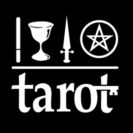Now that you are familiar with the Tarot cards, you have some knowledge of the individual cards, and you can see various patterns made by the four elements, and variations in the ratios between the Major, Minor and Court cards. You can make some judgements about what the cards mean , and that positions such as Past, Present, Future, Love, are not necessary to understand the picture. Now that you can see how the cards interact with each other in a general way, it is time to use a simple set of formal rules using the four elements. The advantage of this system is that it does not need detailed knowledge of the divinatory meanings of each card, so you will be gradually building up more information about what is going on. You will already know that an excess of Water cards shows an emotional picture and that things are generally passive. The next stage is to start using the rules of Elemental Dignities. The Four Elements interact with each other using simple and easy to learn rules:
- Fire and Air are friendly and active
- Water and Earth are friendly and passive
- Fire and Water are enemies; they weaken each other
- Air and Earth are enemies; they weaken each other
- Fire and Earth strengthen each other but are neutral
- Water and Air strengthen each other but are neutral
Rules 1 and 2 show the strongest combination. Rules 3 and 4 show the weakest combination. Rules 5 and 6 are somewhere between. The reason is that they combine Active and Passive. If you can remember Rule 1, and you know that Fire and Air are active, while Water and Earth are passive, you can work out all the other rules easily. There is very little to remember!
If your memory is not so good, and you and have the Thoth Tarot deck, there is a reminder on the back of every card. The horizontal arm shows Fire and Water opposing, while the vertical arm has Air and Earth opposing.
